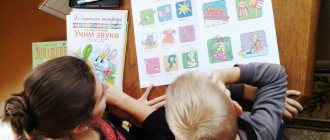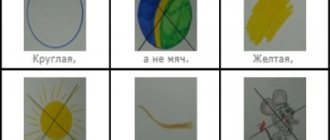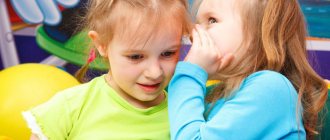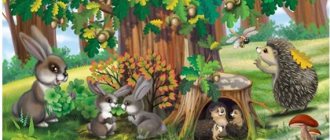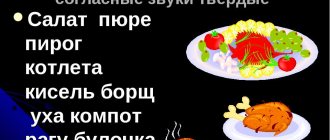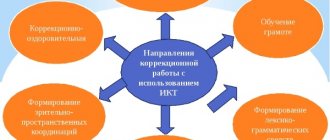Methods of teaching preschoolers storytelling from a picture
Maria Artamonova
Methods of teaching preschoolers storytelling from a picture
Methodological development on the topic : “ Methodology of storytelling based on a picture ”
.
Painting is one of the main attributes of the educational process at the stage of preschool childhood . its positive advantages over other didactic means are disclosed in sufficient detail in teaching aids and textbooks on education (M. M. Konina, E. P. Korotkova, O. I. Radina, E. I. Tikheeva, S. F. Russova, etc. ).
Pictures for working with children are distinguished according to the following criteria: format (demonstration and handouts, themes (natural or objective world, the world of relationships and art, content (artistic, didactic; subject, plot), character (real, symbolic, fantastic, problematic-mysterious, humorous image) and a functional method of application (an attribute for a game, a subject of discussion in the process of communication, an illustration for a literary or musical work, didactic material in the process of learning or self-knowledge of the environment, etc.
General requirements for organizing work with a painting :
1. It is recommended to carry out work on teaching children to tell stories from a picture , starting from the 2nd junior group of kindergarten.
2.When selecting a plot, it is necessary to take into account the number of objects drawn: the younger the children, the fewer objects should be depicted in the picture .
3. After the first game, the picture is left in the group for the entire duration of classes with it (two to three weeks)
and is constantly in the children's field of vision.
4. Games can be played with a subgroup or individually. However, it is not necessary that all children go through every game with a given picture .
5. Each stage of work (series of games)
should
be considered as intermediate . The result of the stage: story using a specific mental technique.
6. The final story can be considered a preschooler’s detailed story , constructed by him independently with the help of learned techniques.
Types of storytelling from a picture
1. Description of subject paintings is a coherent, sequential description of the objects or animals depicted in the painting , their qualities, properties, actions. 2. Description of the subject painting is a description of the situation depicted in the painting , which does not go beyond the content of the painting . 3. A story based on a sequential plot series of pictures : the child talks about the content of each plot picture from the series , linking them into one story . 4. Narrative story based on a plot picture : the child comes up with a beginning and an end to the episode depicted in the picture . He needs not only to comprehend the content of the picture and convey it, but also, with the help of his imagination, to create preceding and subsequent events. 5. Description of landscape paintings and still lifes . An example of a description by I. Levitan "Spring. Big water"
child 6.5 years old: “The snow melted and everything around was flooded. The trees are in the water, and there are houses on the hill. They weren't flooded. Fishermen live in the houses, they catch fish.”
Lesson structure:
1. Part – introductory (1-5 minutes)
. Includes a short introductory conversation or riddles, the purpose of which is to clarify ideas and knowledge, and to prepare children for perception.
2. Part – main (10-20 minutes, where different methods and techniques .
the stories are analyzed and their evaluation is given.
Methodical techniques:
Questions (problematic questions)
Model teacher
Partial teacher sample
Shared storytelling
Story plan
Collective discussion of the plan for the future story
Writing a story in subgroups
Writing a story in subgroups
Evaluation of children's monologues
Stages of learning to tell a story from a picture . Younger age.
In the younger group, the preparatory stage of learning storytelling from a picture . Children of this age cannot yet give an independent coherent presentation. Their speech is in the nature of a dialogue with the teacher.
The main tasks of the teacher in working on a picture come down to the following: 1) teaching children to look at a picture , developing the ability to notice the most important thing in it; 2) a gradual transition from classes of a nomenclature nature, when children list the depicted objects and objects, to classes that practice coherent speech (answering questions and writing short stories )
.
Children learn to tell stories from a picture in sentences of two or three words. Looking at a picture is used to develop accuracy and clarity of speech.
Examination of the paintings is always accompanied by a word from the teacher (questions, explanations, story )
.
After the conversation, the teacher himself talks about what is drawn in the picture . Sometimes you can use a work of fiction (for example, stories by writers about pets)
.
A short poem or nursery rhyme can be read (for example, “Cockerel, cockerel, golden comb”
or
“Little kitten,”
etc.).
You can make a riddle about a pet (for example: “Soft paws, and scratchy paws”
- after
the painting “Cat with Kittens”
).
In the younger group, it is especially important to use a variety of gaming techniques.
Middle preschool age .
Children are taught to examine and describe subject and plot pictures, first according to the teacher’s questions, and then according to his example.
The technique of comparing two characters is used. Conversations are held based on plot pictures , ending with a generalization made by the teacher or the children.
You can play the lexico-grammatical exercise “Continue the sentence”
.
- Let's play. I will start the sentence, and you will continue it. But for this you need to look very carefully at the picture .
• I believe that the painting depicts the beginning of the day because...
In the middle group, a sample is given for copying. " Tell me how I am"
“
Well done, I remembered how I
told you ” says the teacher, i.e. at this age there is no need to deviate from the model.
When children learn to compose short stories of a descriptive nature ( a story about the main qualities, properties and actions of one or more objects or objects) , you can move on to telling based on a sequential plot series of pictures . With the help of a teacher, preschoolers compose a coherent sequential story of a descriptive nature, combining everything into a single whole pictures series .
Senior preschool age .
In older preschool age, due to the fact that children’s activity increases and their speech improves, there are opportunities for independently composing stories based on different pictures .
The content and themes of paintings used in older preschool age require that the lessons be given a greater cognitive and aesthetic emphasis. In the introductory conversation, it may be appropriate to provide brief information about the life and work of the artist - the author of the painting , its genre, a general conversation about the time of year, the life of animals, human relationships, etc., i.e., something that prepares children to perceive the painting . Appeal to children’s own experience, participation in a polylogue corresponding to the topic of the lesson, lexical and grammatical exercises also activate the mental and speech activity of preschoolers and encourage them to take initiative.
In older preschool age, a conversation about the content of the picture can begin with an analysis of its primary or search for a more successful, precise title: “ The picture is called “Winter Fun”
.
Why do you think it is called that way? What does the word “fun”
?” - The teacher addresses the children after a silent
consideration . - “What do you think could be called differently? Explain your option." This allows children to understand and appreciate the picture as a whole in order to move on to a more detailed consideration .
In classes in a preparatory group for school, a teacher’s model should be offered only if the children have poor ability to coherently present the content of a picture . In such classes, it is better to give a plan, suggest a possible plot and sequence of the story . In groups of senior preschool age, all types of stories based on a picture : a descriptive story based on subject and plot paintings , a narrative story , a descriptive story based on a landscape painting and still life .
In the older group, children are introduced to composing narrative stories . So, they come up with a beginning or an end to the plot depicted in the pictures : “That’s how it went for a ride!”
,
“Where did you go?”
,
“Gifts for Mom for March 8th”
,
“The Ball Flew Away”
,
“Cat with Kittens”
, etc. A clearly formulated task encourages you to creatively complete it.
It is very important to teach children not only to see what is depicted in the picture , but also to imagine previous and subsequent events.
In the senior and preparatory groups, work continues to develop the ability to characterize the most significant things in a picture .
Evaluating Stories .
of learning to tell stories from a picture, assessment and analysis of children's stories become important .
In early preschool age, the assessment should only be positive.
In middle age, the teacher analyzes children's stories , emphasizing, first of all, the positive aspects and briefly expresses suggestions for improving the quality of the story . You can encourage children to analyze, asking them to choose a more precise word, to compose a more successful statement: “Children, did you notice how Sasha said about... How else could you say it? Say it in your own way."
Children of senior preschool age actively participate in the analysis of their own stories and the stories of their comrades . This moment in the lesson should be used to improve children’s coherent speech, directing them to more successful lexical replacement, selection and pronunciation of additional options regarding the characteristics of the image, plot line, sentence construction, and narrative structure. That is, this is not just an indication of errors, but an acknowledgment of other variants of the statement.
The methodology for teaching storytelling based on the content of a picture is constantly enriched with new creative discoveries by educators, interesting methods and techniques for managing children’s speech activity.
An effective addition to the conversation on the content of the picture is a modified method of perceiving what is depicted in the picture by various senses, developed by the Russian scientist I. M. Murashkovskaya.
A modern method of using series of plot pictures to develop the coherence of speech of older preschoolers was developed by Russian methodologist A. A. Smirnova, who not only developed a series of paintings , but also proposed an effective technique for stimulating children’s coherent speech.
It is important that when selecting and combining various methodological methods, we do not forget that painting is only an effective means, and the main thing in the lesson is the child, whose development we must guide and accompany.
Compiling a coherent story based on a plot picture. Methodological development in speech therapy on the topic
Evstratova N.V.
Published 10/14/2015
Social network of educators nsportal.ru
Compiling a coherent story based on a plot picture.
Teaching preschoolers to tell stories from a picture is one of the areas of work on the development of coherent speech.
The goal of speech development is defined as achieving the child’s communicative competence.
Connected speech is any unit of speech, the constituent linguistic components of which (significant and function words, phrases) represent a single whole organized according to the laws of logic and the grammatical structure of a given language.
The problem of the peculiarities of children's perception and understanding of paintings was considered in the works of S.L. Rubinshteina, E.A. Flerina, V.S. Mukhina.
The development of coherent speech in preschoolers was dealt with by: A.M. Borodin, F.A. Sokhin, V.V. Gerbova, L.N., Efimenkova, T.A. Ladyzhenskaya, E.I. Tikheyeva, L.P. Fedorenko and others.
The problem of studying coherent speech in preschool children with general speech underdevelopment has been studied by many authors (V.K. Vorobyova, V.P. Glukhov, R.E. Levina, T.B. Filicheva, G.V. Chirkina, A.V. Yastrebova, N. S. Zhukova, E. M. Mastyukova, N. A. Nikashina, T. A. Tkachenko) and others.
S.A. Mironova reveals the content and methods of work on the development of direct speech. N.A. Nikashina reveals the goals of the work on the formation of detailed independent descriptive-narrative speech in children. V.K. Vorobyova has developed a method for the gradual formation of skills and abilities of coherent speech using a picture-graphic plan. T.A. Tkachenko proposes the formation of descriptive storytelling skills using models and diagrams. Teaching creative storytelling is reflected in the works of V.P. Glukhov, T.A. Sidorchuk.
A.V. Yastrebova outlines methods of correctional and developmental teaching of coherent speech for children with special needs, recommends techniques that form full-fledged speech activity. T.B. Filicheva highlights the directions and methods of correctional education for children with special needs (IV level).
Requirements for children's stories
- accurate rendering of the plot;
- independence;
- imagery, appropriateness of using linguistic means (precise designation of actions);
- the presence of connections between sentences and parts of the story;
- expressiveness, ability to intonate, emphasizing the most significant words;
- fluency of speech, phonetic clarity of each phrase
- Interesting, understandable content that fosters a positive attitude towards the environment.
Requirements for the painting
- Realistic image.
- The painting must be highly artistic
- Accessibility of content and image (absence of many details, strong reduction and obscuring of objects, excessive shading, sketchiness, incompleteness of the drawing)
General requirements for organizing work with a painting:
1. It is recommended to carry out work on teaching children to tell stories from a picture, starting from the 2nd junior group of kindergarten.
2. When selecting a plot, it is necessary to take into account the number of objects drawn: the younger the children, the fewer objects should be depicted in the picture.
3. After the first game, the picture is left in the group for the entire duration of classes with it (two to three weeks) and is constantly in the children’s field of view.
4. Games can be played with a subgroup or individually. However, it is not necessary that all children go through every game with a given picture.
5. Each stage of work (series of games) should be considered as intermediate. The result of the stage: the child’s story using a specific mental technique.
6. The final story can be considered a preschooler’s detailed story, constructed by him independently with the help of learned techniques.
Types of activities for teaching children to tell stories from a picture
- Compiling a descriptive story based on an object picture.
- Compiling a descriptive story based on a plot picture.
- Coming up with a narrative story based on a plot picture.
- Compiling a story based on a sequential plot series of paintings.
- Compiling a descriptive story based on a landscape painting and still life.
- Creative storytelling based on a plot picture.
Types of storytelling from a picture
1. Description of object paintings is a coherent, sequential description of the objects or animals depicted in the picture, their qualities, properties, actions
2. Description of the subject picture is a description of the situation depicted in the picture, which does not go beyond the content of the picture.
3. A story based on a sequential plot series of pictures: the child talks about the content of each plot picture from the series, linking them into one story.
4. Narrative story based on a plot picture: the child comes up with a beginning and an end to the episode depicted in the picture. He needs not only to comprehend the content of the picture and convey it, but also, with the help of his imagination, to create preceding and subsequent events.
5. Description of a landscape painting and still life. An example of a description of I. Levitan’s painting “Spring. Big water” by a 6.5 year old child: “The snow melted and everything around was flooded. The trees are in the water, and there are houses on the hill. They weren't flooded. Fishermen live in the houses, they catch fish.”
Teaching children to look at pictures
Stages of learning to tell a story from a picture:
Junior preschool age:
the preparatory stage is carried out,
its goal is to enrich the vocabulary, activate children’s speech,
teach them to look at pictures and answer questions about their content.
Didactic games are carried out with subject pictures:
kids must match the indicated picture, name the object, say what it is, what they do with it.
When working with children, we use subject and plot pictures that are close to the children’s experience and evoke an emotional response: “Cat with Kittens”, “Dog with Puppies”, “Cow with Calf”, “Our Tanya”.
The main type of lesson on painting is conversation. Children learn to tell stories with the help of the teacher's questions. The teacher sets the pattern, and the children add: “The cat Murka is lying on ... (rug), she has small ... (kittens).” Author's stories on the topic, riddles, short poems, nursery rhymes are used.
Middle preschool age:
Children are taught to examine and describe subject and plot pictures, first according to the teacher’s questions, and then according to his example.
The technique of comparing two characters is used. Conversations are held based on the plot pictures, ending with a generalization made by the teacher or the children.
Lesson structure:
1. children silently look at the picture,
2. a conversation is held to clarify the content and details,
3. a sample is given (short, lively, emotional),
4. children reproduce the sample,
5. tell stories independently, bringing their own creativity into the story.
Senior preschool age:
Children, independently or with a little help from the teacher, describe subject and plot paintings, compose plot stories based on a series of paintings, and come up with the beginning and end of the plot of the painting.
The learning tasks become more complicated: children must not only understand the content of the picture, but also coherently and consistently describe all the characters, their relationships, and the setting, using a variety of linguistic means and more complex grammatical structures. The main requirement is greater independence in telling stories based on pictures.
In the older group, the following paintings are recommended:
“The Ball Flew Away”, “New Girl”, “At the Pier”, “Horse with a Foal”, “Hedgehogs”, “Squirrels”, etc.
Children are taught the following types of statements:
- description and comparison of subject pictures;
- description of plot paintings;
- a narration based on a series of plot paintings. Descriptive story
Goal: development of coherent speech based on the display of what is seen.
Types of descriptive story:
- fixation of the objects depicted in the picture and their semantic relationships;
- description of the picture as a disclosure of a given theme;
- a detailed description of a specific object;
- verbal and expressive description of what is depicted using analogies (poetic images, metaphors, comparisons, etc.).
Children are led to storytelling through a series of story pictures (no more than three).
Each picture from the series is examined and described, then the children’s statements are combined into one story by the teacher or children.
Lesson structure:
Examination of paintings and clarification of the main points of the plot are used. Methodological techniques: questions, speech sample, collective storytelling, discussion of the narrative sequence, creative tasks, plan in the form of questions and instructions.
Training in constructing a story based on a series of plot pictures continues.
1. A set of pictures with a deliberately broken sequence is displayed on the board. Children find a mistake, correct it, come up with a story title and content based on all the pictures;
2. The entire series of pictures is on the board, the first picture is open, the others are closed. After describing the first, the next one is opened in order; Each picture is described. At the end, the children give the name of the series and select the most successful one;
3. children place in the correct sequence incorrectly
arranged pictures, then make up a story about the whole series.
They agree among themselves who will tell the story in what order.
School preparatory group:
Children independently compose descriptions and narratives based on the pictures, correctly conveying the content, observing the appropriate structure, and using figurative speech.
All types of pictures and all types of children's stories are used. Particular attention is paid to independence and creativity. A work of art is often used as a speech sample: short stories by L. N. Tolstoy, K. D. Ushinsky, E. Charushin, V. Bianki.
Lesson structure:
The story is based on the multi-episode films “Winter Fun”, “Summer in the Park”, “City Street”. The paintings are examined in parts, creative tasks are used, and children are encouraged to ask questions themselves; the vocabulary is activated and enriched with figurative expressions (epithets, comparisons, metaphors). The teacher can start a story about one of the episodes, the children continue. Instructions are used on who to start, what to tell first, and in what sequence to develop the plot. After such explanations and instructions, children take part in collective storytelling.
Teaching children to tell stories from a picture
A special type of coherent statement is descriptive stories based on a landscape painting. This type of story is especially difficult for children. If, when retelling and composing a story based on a plot picture, the main elements of the visual model are characters - living objects, then in landscape paintings they are absent or carry a secondary semantic load.
In this case, natural objects act as elements of the story model. Since they, as a rule, are static in nature, special attention is paid to describing the qualities of these objects.
Work on such paintings is built in several stages:
- highlighting significant objects in the picture;
- examination of them and a detailed description of the appearance and properties of each object;
- determining the relationship between individual objects in the picture;
combining mini-stories into a single plot.
As a preparatory exercise in developing the skill of composing a story based on a landscape painting, we can recommend the work “Bring the Picture to Life.” This work is like a transitional stage from composing a story based on a plot painting to telling a story using a landscape painting.
Writing descriptive stories
- Selecting the name of the painting (tasks like “What did the artist call this painting?”, “Let’s come up with a name”, “What can we call this painting?”)
- Characteristics of the most essential and details.
- Coming up with a beginning or an end to the plot depicted in the picture.
- Questions for children about the plot line of a narrative story.
- Compiling a collective story based on the picture.
- Incorporating an element of competition: which group's story will be the most interesting?
Creative storytelling from a painting
- Compose a story with subsequent events added.
- Compiling a story with a replacement object.
- Compiling a story with a replacement character.
- Compiling a story with the addition of previous events.
- Compiling a story with the addition of previous and subsequent events.
- Compose a story with the addition of an object.
- Compose a story with the addition of a character.
- Compiling a story with the addition of objects and characters.
- Compiling a story with a change in the outcome of an action.
- Compiling a story with a change in the time of action.
When teaching storytelling, you can use the visual modeling method.
A visual model of an utterance acts as a plan that ensures the coherence and sequence of the child’s stories.
When teaching storytelling, effectively use mnemonic techniques, sensory-graphic diagrams (Vorobyova V.K.), subject-schematic models (Tkachenko T.A.), square blocks (Glukhov V.P.), collages (Bolsheva T.V. ), schemes for compiling a story. (Efimenkova L. N.)
The following are used as substitute symbols when modeling creative stories:
- subject pictures;
- silhouette images;
- geometric figures.
Elements of a story plan based on a landscape painting can be silhouetted images of its objects, both clearly present in the painting and those that can only be identified by indirect signs.
To compose descriptive stories about a subject, you can use:
- Schemes for compiling descriptive stories Vasilyeva S.A., Miryasova V.I.;
— Schemes T.A. Tkachenko;
— Schemes by Teremkova N.E.;
— Subject plan of Vorobeva V.K.
- The teacher offers children a graphic description model, which is also a program for research activities.
- It includes 3 parts:
Part 1 – a list of symbols indicating the sensory channel;
Part 2 – is a list of characteristics;
Part 3 – image of the object itself.
To compose narrative stories you can use:
- subject-graphic plan (Vorobeva V.K.)
- Introducing children to the chain type of text.
- The squares in the table are subject components, subject and object. They are filled with subject pictures (or words written on a card). The arrow denotes a predicate expressed by a verb word.
- Children are introduced to the rules of semantic connection between sentences in a story. This method of graphic recording makes it possible to clearly demonstrate the basic rule of semantic connection of sentences in a narrative story through the repetition of subject meanings.
- The teacher introduces children to the rules of linguistic, lexical-syntactic connection of sentences in the story (pronouns, synonyms, derivative words).
The teacher marks this place (subject pictures) either with a “prohibition” chip or with a “question” chip (a square with a question mark).
To compose a story based on a plot picture, it is effective to use mnemonics.
Mnemonics - translated from Greek - “the art of memorization.” This is a system of methods and techniques that ensure successful memorization, preservation and reproduction of information, knowledge about the characteristics of natural objects, the world around us, effective memorization of the structure of a story, and, of course, the development of speech.
The essence of mnemonic schemes is as follows: for each word or small phrase, a picture (image) is created; thus, the entire text is sketched schematically. Looking at these diagrams - drawings, the child easily reproduces textual information.
A story based on a plot picture.
Work on developing the skill of storytelling from a picture consists of 3 stages:
- highlighting fragments of the picture that are significant for the development of the plot;
- determining the relationship between them;
- combining fragments into a single plot.
At this stage of the work, the following manuals are used: “Logical Baby”, “Limpopo”, “Bring the Picture to Life”. Somehow Sunny’s temperature rose. It went to the doctor, and along the way its hot rays touched everything. The sun touched the snow cloud, and it turned into a white fluffy cloud. The Sun touched the icicles on the roof, and droplets dripped from them, the droplets rang loudly. The beam hit a snowdrift, and a thawed patch appeared in this place. The sun touched the tree branch, and the first leaves appeared from the swollen buds. And when a ray of sun touched the bird, it sang a cheerful song. The Sun looked around, and instead of winter, SPRING came on earth.
FRAGMENTARY STORY FROM A LANDSCAPE PICTURE
To increase the effectiveness of work on developing the skill of composing stories based on a picture, we can recommend the technique of fragmentary storytelling, when children first compose stories about individual characters (fragments) of the picture, and then combine them into a single statement. The picture proposed for the story is divided into 4 parts, which are covered with cardboard rectangles of different colors. The child, gradually revealing each of the 4 parts of the picture, talks about each fragment, combining them into one plot. Work on each of the fragments is similar to the work on compiling a description of the whole picture. Variation in children's stories is achieved through their choice of the color of the rectangle that they open first.
Speech therapy fairy tale (fairy tales by V. Volina, A. Tsyferov)
One of the methods of teaching children coherent retelling is working with speech therapy fairy tales. A speech therapy fairy tale is a text with fabulous content, containing as many identical sounds as possible. The use of such fairy tales in work allows us to solve, along with the tasks of mastering the skill of sequential and coherent retelling, the task of automating spoken sounds in coherent speech.
Working with a speech therapy fairy tale proceeds as follows:
- a speech therapist reads a fairy tale to a child;
- the child lays out a model of a fairy tale (a picture or consisting of substitute symbols, choosing them arbitrarily);
- then the child answers questions about the content of the fairy tale;
- the speech therapist models fragments of a fairy tale, the child retells the text corresponding to this fragment;
- the child retells the fairy tale according to the model.
A CREATIVE TALE BASED ON SILHOUETTE IMAGES
One of the techniques for developing creative storytelling skills is teaching children to compose fairy tales using silhouette images. As elements of the model, the child is presented with silhouettes of animals, plants, people or natural phenomena (snow, rain, etc.). The speech therapist sets the beginning of the fairy tale and suggests continuing it, based on the silhouette images. In the dark forest, in its very depths, there is a sunny clearing. A flower grows in the center of the clearing... (then the children choose the silhouettes of other characters and finish the fairy tale). The peculiarity of these elements is that silhouette images, unlike painting material, set a certain generalized image without revealing its semantic content. Determining the character, mood, even appearance of the hero is the prerogative of the child himself. Children endow the silhouettes of objects with certain semantic qualities. At subsequent stages, the child himself comes up with the plot of a fairy tale on a given topic, choosing silhouettes for the model in accordance with his plan.
The method of teaching preschool children to work with a series of plot pictures allows children to master logical operations and correctly complete the task. Compilation of a story based on a series must be preceded by preparatory work. With the help of additional questions, the content of the future story is analyzed, and work on the lexical and grammatical material continues. New words are clarified, fixed in different grammatical forms and connections. When composing stories based on a series of pictures, children simultaneously practice composing dialogues in relation to a specific situation.
Teaching preschoolers to work with a series of pictures should begin at the age of three. Children of this age are offered 2–3 pictures to compose a series.
By the age of four, the volume of the series increases to 4–5 pictures. Their stories should reflect the real experience of children (the process of washing, feeding, going to bed, etc.)
At the age of five, a child can be offered up to 6 pictures in a series based on typical events experienced by children at this age (buying something in stores, going to the zoo or the forest). At the same age, you can use a series of pictures based on fairy-tale situations (a hedgehog collects apples in the forest, makes jam and treats them to forest animals).
When children are five to seven years old, it is more advisable to use a series of pictures from 6 to 8 frames, connected by a variety of content (from the personal experience of children, from actions observed from the outside; the use of fairy-tale situations from literary works unfamiliar to children).
In all cases, it is not recommended to use a series of pictures with a broken logical chain. It is also not recommended to use pictures related to the texts of literary works familiar to children.
Gaming techniques:
- find the teacher’s “mistake” and restore the correct order of the elements of the series;
- select from a number of proposed plot pictures only those that illustrate the story read by the teacher;
- restore the given order of pictures from a previously read story (from memory);
- correct the “mistake” in the teacher’s reading of the story by correctly arranging the pictures in the series;
- independently arrange the pictures in the sequence of the story and compose a story based on them (you can have a certain emotional attitude: sad, funny, cheerful, etc.)
- find an extra picture;
- include in stories descriptions of the landscape, weather conditions, descriptions of the characters’ facial expressions and gestures, direct speech of the characters (what the hero thought, what he said)
- teach children to start and end stories in different ways.
Literature.
1. Bakaeva M.N. Development of mediated memory when memorizing poetry with the help of visual supports // Speech therapist. - 2011. - No. 7. - 120s
2. Korvyakova N. F. The use of pictograms in working with children with special needs // Problems of pathology of development and decay of speech function. – St. Petersburg, 1999.
3. Lalaeva R. I., Serebryakova N. V. Formation of vocabulary and grammatical structure in preschool children with general speech underdevelopment. – St. Petersburg, 2001.
4. Maletina N.S., Ponomareva L.V. Modeling in descriptive speech of children with special needs development / Preschool education. 2004.№6. pp. 64-68.
5. Omelchenko L.V. Using mnemonic techniques in the development of coherent speech / Speech therapist. 2008. No. 4. P.102 -115

